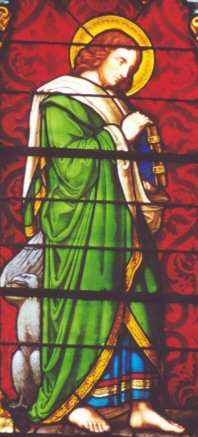
John 20:1-9
Death, where is your sting?
by Rev. Robert J. Wagner
Reprinted with permission of "The Arlington Catholic
Herald"
Home Page
To Sunday Gospel Reflections Index
John wrote to show that Christ was
the Messiah, the Divine Son of God.

On the first day of the week, Mary of Magdala came to the tomb early in the morning, while it was still dark, and saw the stone removed from the tomb. So she ran and went to Simon Peter and to the other disciple whom Jesus loved, and told them, "They have taken the Lord from the tomb, and we don't know where they put him." So Peter and the other disciple went out and came to the tomb. They both ran, but the other disciple ran faster than Peter and arrived at the tomb first; he bent down and saw the burial cloths there, but did not go in. When Simon Peter arrived after him, he went into the tomb and saw the burial cloths there, and the cloth that had covered his head, not with the burial cloths but rolled up in a separate place. Then the other disciple also went in, the one who had arrived at the tomb first, and he saw and believed. For they did not yet understand the Scripture that he had to rise from the dead.
Paradoxically, the first moments at the empty tomb of the Risen Jesus were not joyful, but instead filled with fear and confusion, according to the Gospel of St. John. Mary Magdalene was stunned to see the empty tomb on that first Easter morning. Fearing foul play, she ran to tell the Apostles, and, shocked by the news, Peter and John immediately ran to the tomb to see for themselves.
St. John (“the disciple whom Jesus loved”) was an eyewitness to the scene. In his Gospel he tells us what they found at the empty tomb: the burial cloths laid in one area and the cloth that covered the face of Our Lord, which someone had taken the effort to roll up and position in a separate place. That was all. What they did not find was the body of Jesus, and John writes, “they did not yet understand the Scripture that (Jesus) had to rise from the dead” (cf. Jn 20:9). They were confused. They were saddened by the absence of their Lord's body .
Taken by itself, this is a rather bleak scene. After twenty centuries, however, we know why the tomb was empty that morning. We know what Jesus meant when He said, “Destroy this temple and in three days I will raise it up” (cf. Jn 2:19). So while the witnesses at the empty tomb had never encountered the reality of the Resurrection, we have come to hope and believe in this central mystery of our faith. We know that Jesus appeared to many of His disciples after the Resurrection, including these same three. We also are gifted with the fruits of the church’s contemplation of this mystery over the many years since that dark morning in Jerusalem.
In that first moment when Peter, John and Mary Magdalene faced the event that changed the history of humanity, they could not grasp what had happened and instead allowed fear, confusion and sadness to enter into their lives.
In a similar way, we, too, sometimes can be surrounded by fear, darkness and confusion when we forget the reality of Our Lord's Resurrection. We confess this doctrine of our faith every time we recite the creed, but even so, we can find ourselves numb to the stunning beauty and promise it offers us.
We confront it every time we face death, especially the death of a loved one, or, more intensely, when we are forced to recognize our own mortality. Certainly, we cannot disregard the sadness that accompanies the passing of someone dear to us or the thought of passing from this life on earth. Our desire to be with those we love naturally drives us to mourn the separation caused by death. Yet with the Easter victory, that separation is now revealed as a physical separation only. It is not eternal. The departed are not truly gone, for Jesus has conquered death. St. Paul, enlightened and emboldened by the Resurrection, tells us, “Death is swallowed up in victory. Where, O death, is your victory? Where, O death, is your sting?” (cf. 1 Cor 15:54-55).
In time, Peter, John and Mary Magdalene understood and experienced the joy of the Resurrection. They may have even contemplated the confusion and fear they experienced on that first Easter and recognized how their hearts had become lighter and more joyful in knowing that death had been overcome by the power and love of God.
We are called to rejoice in that same reality. By rising from the dead, Jesus has, in a sense, moved the finish line. Death is no longer the end, for now we are promised life eternal. May all of our thoughts, prayers, and actions be focused on the truth that we are created to be with Our Lord not only in this life, but beyond, where “there shall be no more death or mourning, wailing or pain” (cf. Rev 21:4).
Jesus Christ has risen.